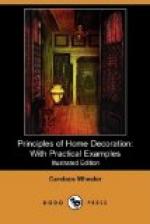There is one fault very common in houses which date from a period of some forty or fifty years back, a fault of disproportionate height of ceilings. In a modern house, if one room is large enough to require a lofty ceiling, the architect will manage to make his second floor upon different levels, so as not to inflict the necessary height of large rooms upon narrow halls and small rooms, which should have only a height proportioned to their size. A ten-foot room with a thirteen-foot ceiling makes the narrowness of the room doubly apparent; one feels shut up between two walls which threaten to come together and squeeze one between them, while, on the other hand, a ten-foot room with a nine-foot ceiling may have a really comfortable and cozy effect.
In this case, what is needed is to get rid of the superfluous four feet, and this can be done by cheating the eye into an utter forgetfulness of them. There must be horizontal divisions of colour which attract the attention and make one oblivious of what is above them.
Every one knows the effect of a paper with perpendicular stripes in apparently heightening a ceiling which is too low, but not every one is equally aware of the contrary effect of horizontal lines of varied surface. But in the use of perpendicular lines it is well to remember that, if the room is small, it will appear still smaller if the wall is divided into narrow spaces by vertical lines. If it is large and the ceiling simply low for the size of the room, a good deal can be done by long, simple lines of drapery in curtains and portieres, or in choosing a paper where the composition of design is perpendicular rather than diagonal.
To apparently lower a high ceiling in a small room, the wall should be treated horizontally in different materials. Three feet of the base can be covered with coarse canvas or buckram and finished with a small wood moulding. Six feet of plain wall above this, painted the same shade as the canvas, makes the space of which the eye is most aware. This space should be finished with a picture moulding, and the four superfluous feet of wall above it must be treated as a part of the ceiling. The cream-white of the actual ceiling should be brought down on the side walls for a space of two feet, and this has the effect of apparently enlarging the room, since the added mass of light tint seems to broaden it. There still remain two feet of space between the picture moulding and ceiling-line which may be treated as a ceiling-border in inconspicuous design upon the same cream ground, the design to be in darker, but of the same tint as the ceiling.
The floor in such a room as this should either be entirely covered with plain carpeting, or, if it has rugs at all, there should be several, as one single rug, not entirely covering the floor, would have the effect of confining the apparent size of the room to the actual size of the rug.




